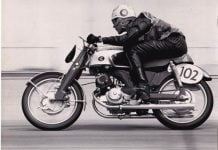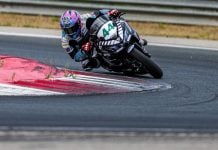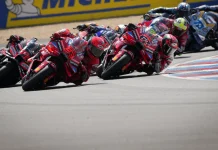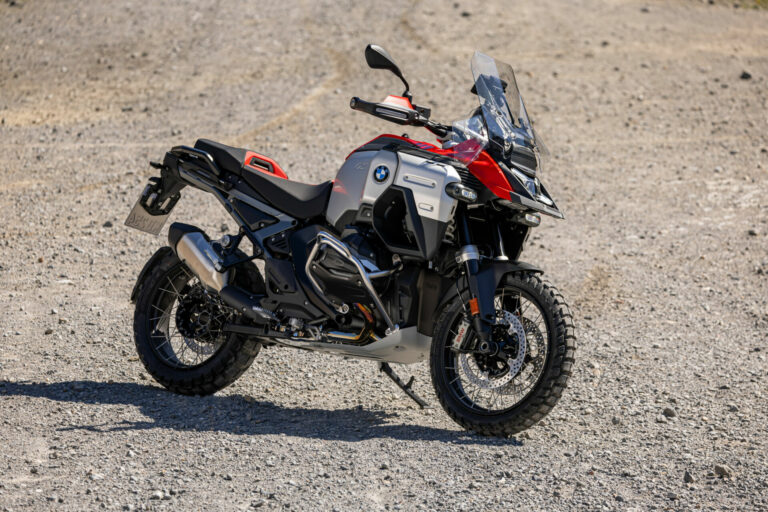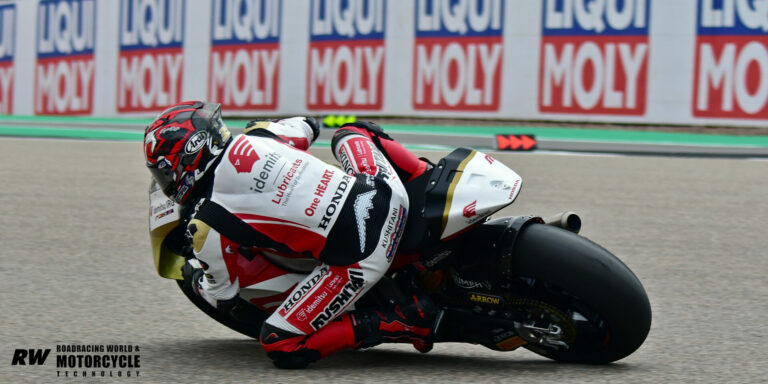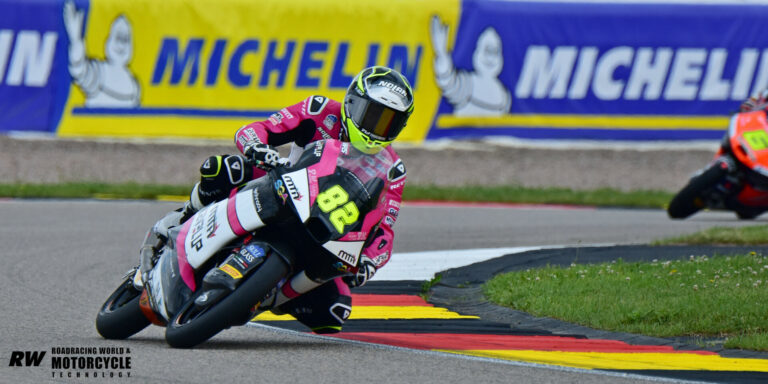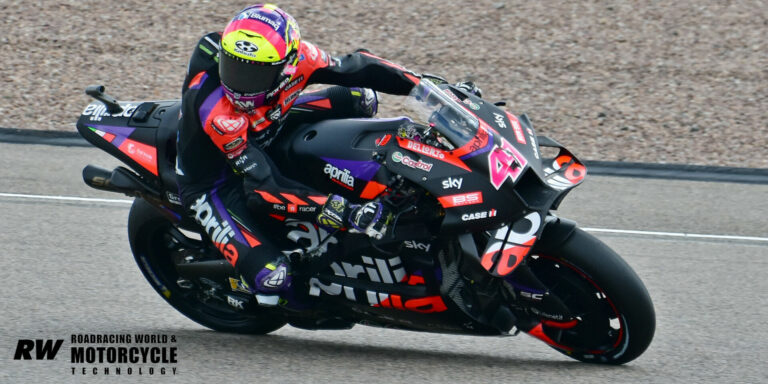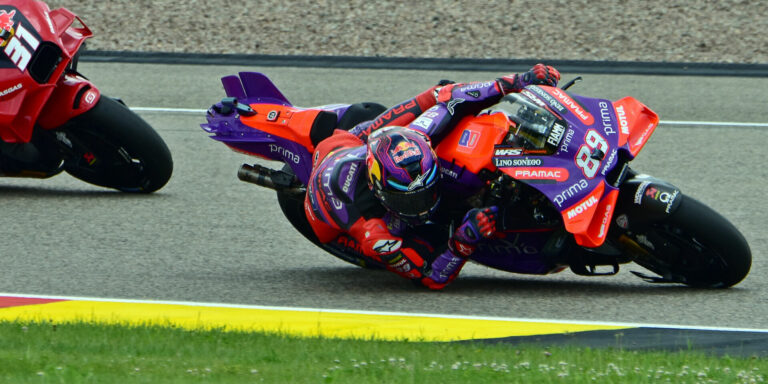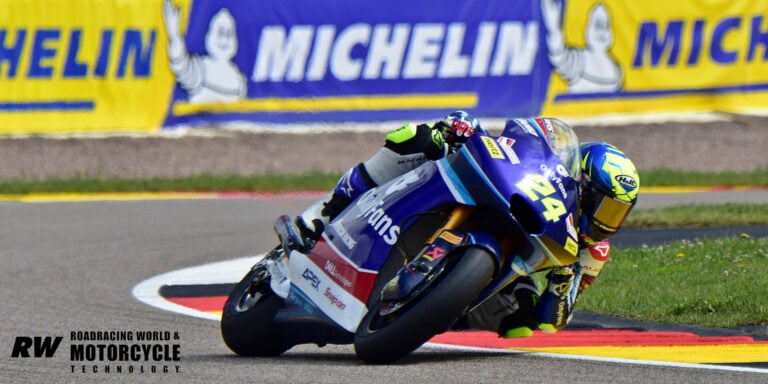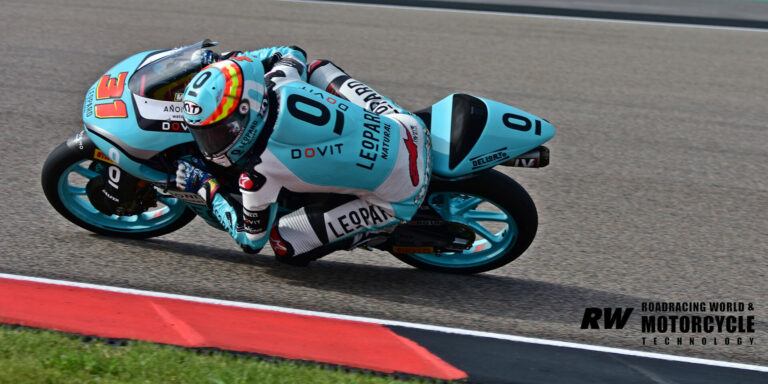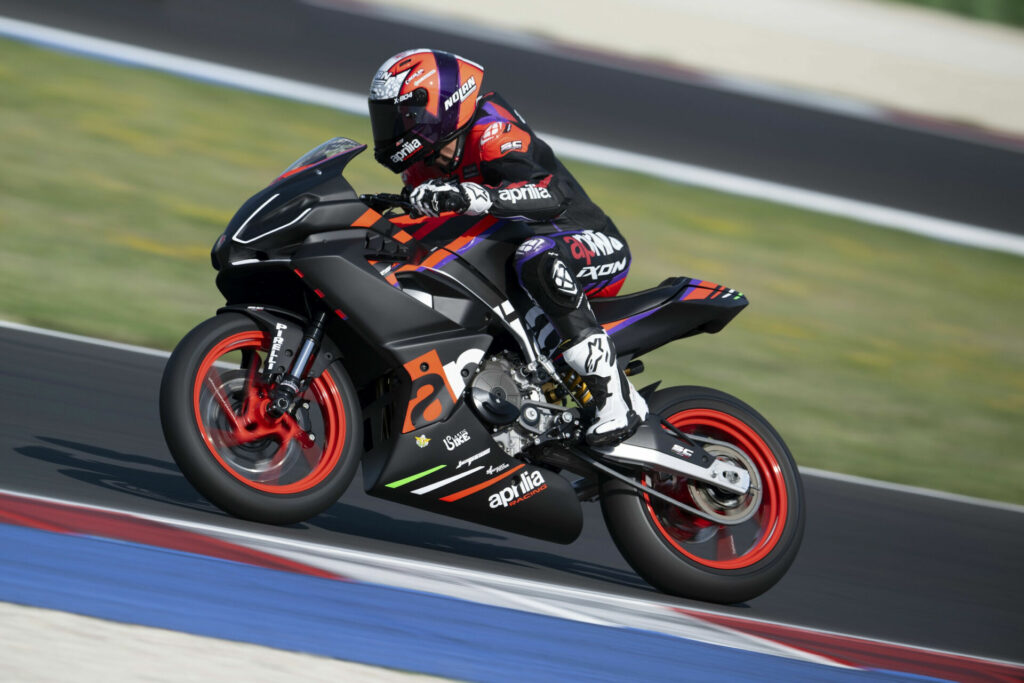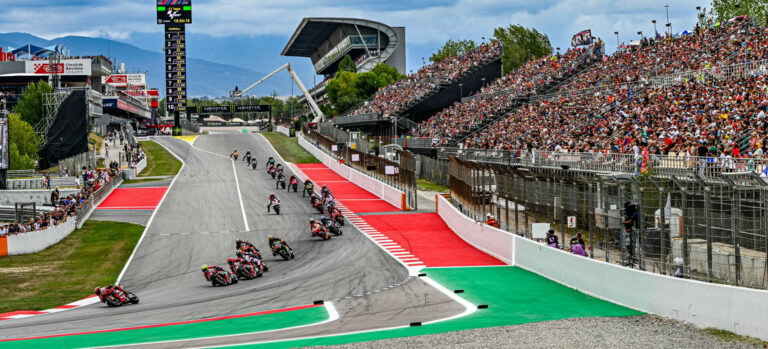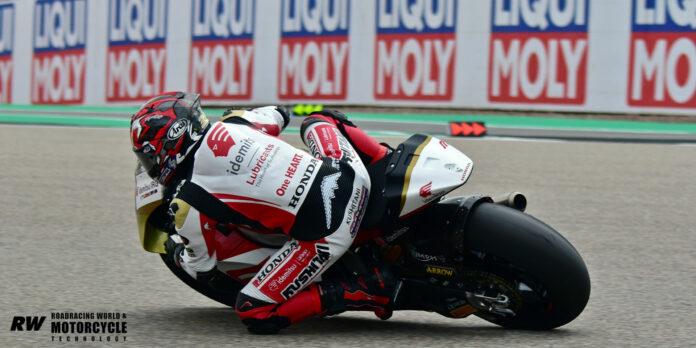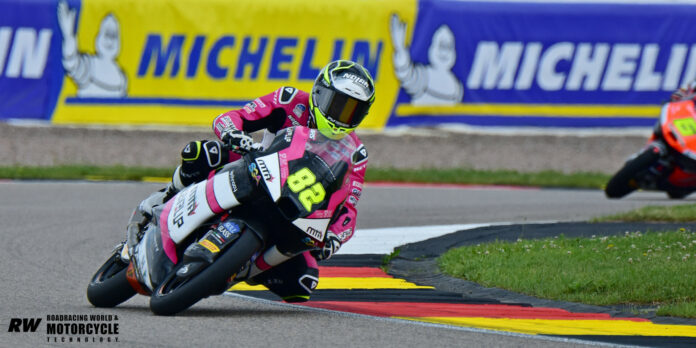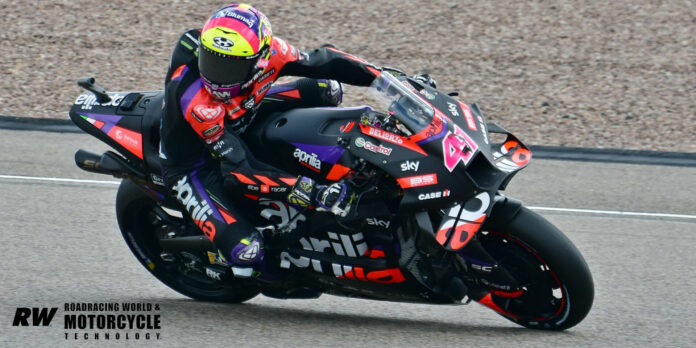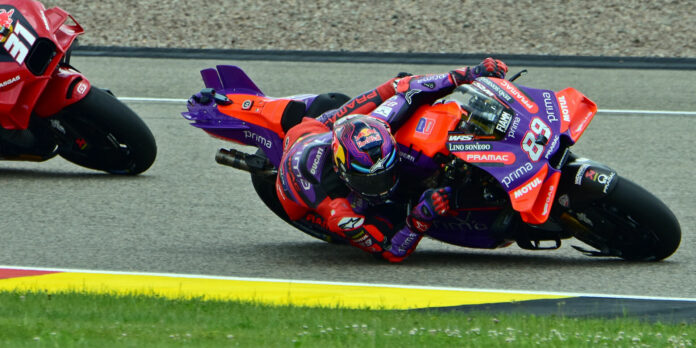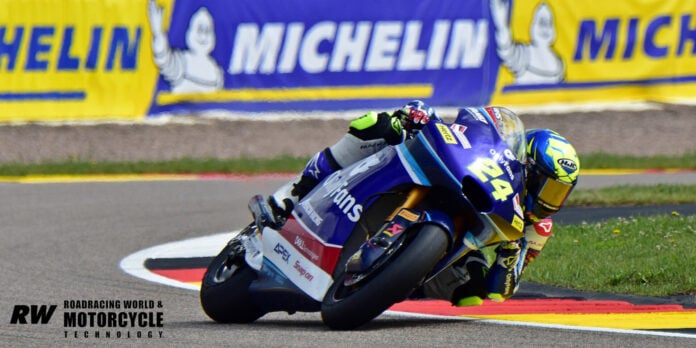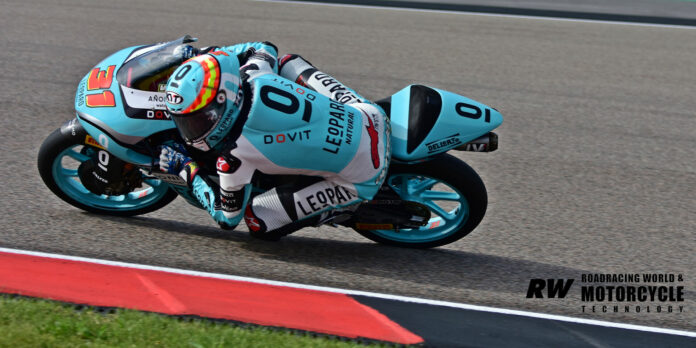The new 2025 BMW R 1300 GS Adventure.
- The big GS for adventure riding and long-distance touring.
- Optional ASA Automated Shift Assistant.
- Clever fuel tank equipment mounting points.
- Market Launch in Q4 2024.
- Pricing will be announced closer to Market Launch.
Woodcliff Lake, NJ – July 5, 2024…BMW Motorrad proudly presents the new 2025 BMW R 1300 GS Adventure, carefully designed, and crafted to support all your adventure riding and long distance touring wishes and needs. With a new engine, completely redesigned chassis, the availability of Automated Shift Assistant and electronic systems to enhance not only safety but also accessibility for a wider range of riders, the new big GS Adventure is your versatile and indispensable travel multi-tool.
Crossing the Sahara in searing heat, climbing the Himalayas, or exploring the Amazon rainforests – for more than two decades the big BMW GS Adventure boxer engine has been synonymous with long-distance motorcycle journeys. To ensure that this remains the case in the future, and to provide adventurous motorcyclists with even more capabilities, BMW Motorrad has an almost completely redesigned the engine, chassis, bodywork, design, and storage concept of the new R 1300 GS Adventure compared to the previous model, taking the cornerstones of the BMW GS Adventure to a new level.
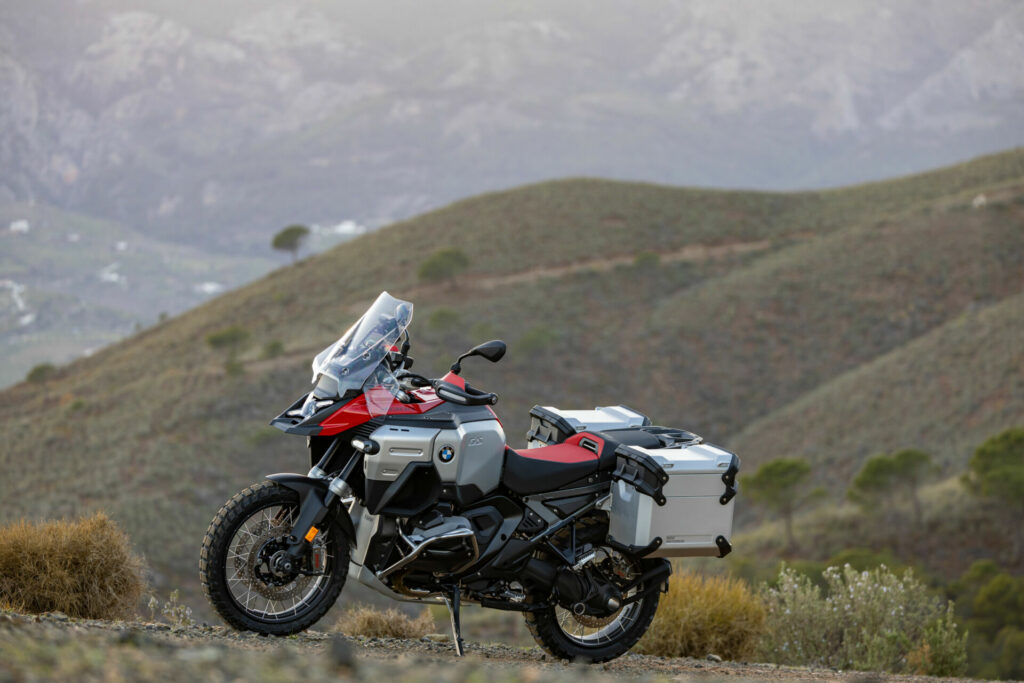
“The appearance of the new BMW R 1300 GS Adventure is sure to attract attention. The big GS is not only visually different from its almost dainty sister. Never before have seating comfort, ergonomics and wind and weather protection been so harmoniously combined with precise handling, exceptional suspension comfort and smooth running. The new BMW R 1300 GS Adventure has set itself the goal of becoming the benchmark for large adventure motorcycles.” Christof Lischka, Head of BMW Motorrad Development.
The highlights of the new BMW R 1300 GS Adventure:
- The Automated Shift Assistant (ASA) with automated clutch operation makes motorcycling even more convenient and offers an exciting new riding experience through automated gearshifts.
- New boxer engine with bottom-mounted transmission and BMW ShiftCam technology. Most powerful BMW boxer engine ever.
- Strong torque across the entire engine speed range, exemplary fuel economy, emission levels, running smoothness and refinement.
- Power and torque: 145 hp at 7,750 rpm and 110 ft-lbs. at 6,500 rpm.
- Advanced knock sensor system.
- Completely redesigned chassis with sheet metal main frame and aluminum lattice tube rear frame. Even greater steering precision and riding stability thanks to new EVO Telelever with flex element and revised EVO Paralever rear wheel guide.
- 7.9-gallon aluminum tank.
- Standard BMW Motorrad Full Integral ABS.
- Standard Engine Drag Torque Control (MSR), Dynamic Brake Control (DBC), Dynamic Traction Control (DTC) and Hill Start Control (HSC).
- Standard four riding modes.
- Optional Riding Modes Pro with three additional riding modes.
- Optional Electronic Dynamic Suspension Adjustment (DSA) with dynamic adjustment of the damping and spring rate as well as load compensation.
- Optional Adaptive Vehicle Height Control or Adaptive Vehicle Height Control Comfort.
- Standard Matrix LED headlights and newly developed auxiliary lights integrated into the body.
- Optional Headlight Pro with adaptive headlight.
- Standard hand protectors with integrated turn indicators.
- Standard Dynamic Cruise Control (DCC) with brake function.
- Optional Riding Assistant with Active Cruise Control (ACC), Front Collision Warning (FCW) and Lane Change Warning for safe and convenient motorcycling.
- Standard Smartphone charging compartment with integrated USB socket and 12 V on-board power socket.
- Optional rider and passenger seat heating.
- Optional handlebar risers up to 30 mm / 1.2-inches.
- Wide range of available seat heights.
- Standard Connectivity with 6.5-inch full-color TFT multifunctional display.
- Standard TPM, Keyless Ride and heated grips.
- Standard Intelligent Emergency Call.
I. Engine and Drivetrain
“The uniquely powerful propulsion and smooth running of the 1,300 cc boxer engine contribute significantly to the harmonious riding experience of the new R 1300 GS Adventure. With the optional Automated Shift Assistant (ASA), it also offers an innovative technical solution to make long-distance touring and adventure riding even easier and more comfortable”. Patrick Gürlich, Project Manager BMW R 1300 GS Adventure.
Newly developed boxer engine, with more power and torque as well as improved smoothness and efficiency.
Like the BMW R 1300 GS, the new BMW R 1300 GS Adventure is powered by the powerful and completely redesigned boxer engine. It has a capacity of exactly 1,300 cc while the ratio between bore and stroke is 106.5 to 73 mm (predecessor: 102.5 to 76 mm). This increase in capacity derives from an enlarged cylinder bore and a new crankshaft with reduced stroke. It has a power output of 145 hp (predecessor: 136 hp), still generated at 7,750 rpm, and develops a maximum torque of 110 ft-lbs. 6,500 rpm (predecessor: 105 ft-lbs. at 6,250 rpm), making it by far the most powerful serial production BMW boxer engine to date. The maximum engine speed is 9,000 rpm.
In addition to the increased maximum output compared to the predecessor model, the new BMW R 1300 GS Adventure also benefits from more torque, which is noticeably higher, than in the predecessor model, across the entire engine speed range, especially in the dynamically relevant range between 3,600 and 7,800 rpm, where a level of more than 96 ft-lbs. is constantly available. This makes the new R 1300 GS Adventure more capable than ever before, combining enormous drive power with impressive peak power output. And this contributes to the riding fun both solo and with a passenger, for sporty runs on winding roads, and on extended road riding sessions at a higher speed.
At the same time the efficiency was also optimized. Despite a significant increase in power and torque, the fuel consumption of the new BMW R 1300 GS Adventure is almost identical to that of its predecessor. The new boxer engine sets standards in terms of running smoothness, too, offering a more direct response to throttle commands thanks to reduced load reversal cycles in the powertrain. Ideal alignment of the engine-frame also ensures an excellent vibration response.
The boxer engine in the new R 1300 GS Adventure still uses the well-established air/liquid cooling system where coolant flows through the engine elements that are subject to thermal stress, such as the cylinder heads. Other features that are retained include the vertical-flow cylinder heads, variable oil intake, effective piston base cooling and the DOHC valve gear with light cam followers. In the new boxer engine, the two camshafts are driven on each side of the cylinder by a timing chain running over both camshafts, each from a reduction sprocket. On the right-hand side, the drive is located in front of the cylinder, while on the left-hand side the timing chain shaft is arranged behind the cylinder. Furthermore, the engine of the new BMW R 1300 GS Adventure features the tried-and tested knock sensor system and the BMS-O engine management system for highly effective air-fuel ignition.
With increased power and torque, the new engine features an increased compression ratio of 13.3:1 (predecessor: 12.5:1). The gain in power and torque with high efficiency is due to recalculated timing and larger valve diameters: These now measure 44 mm instead of 40 mm on the intake side and 35.6 mm instead of 34 mm on the exhaust side.
New transmission, now located below the engine for more compact packaging with reduced weight. New shaft drive and hub.
The six-speed transmission and clutch are integrated in the engine housing in the new R 1300 GS Adventure. As on the R 1300 GS, the transmission is no longer located behind the engine, but underneath it. The advantages of this new arrangement are a reduced overall length and improved packaging and weight balance since it was possible to make the transmission shafts significantly shorter. Compared to the engine of the previous models, a total basic engine weight saving of 8.6 lbs. was achieved. At the same time, the greater concentration of mass towards the overall center of gravity ensures even better handling qualities. As before, power is transmitted to the six-speed transmission via a 10-disk wet clutch with a self-reinforcing anti-hopping mechanism. Output is via two spur gears, one of which has an integrated vibration damper.
To increase shifting precision, the transmission now has a sensor signal transmitter for the optional Shift Assistant Pro based on a new concept involving a torsion magnet. This is reflected in a much more direct feel when shifting gears.
The shaft drive and rear axle hub have also been newly designed. The shaft drive now has larger universal joints, and the reduced deflection angle also reduces the non-uniformity of the rotational transmission that is inherent in propeller shaft joints. The rear axle hub has been redesigned and now has a longer wheel axle stub for easier mounting and dismounting of the rear wheel.
BMW ShiftCam technology for smoothness, excellent fuel economy and emissions.
The boxer engine of the new BMW R 1300 GS Adventure is equipped with the unique BMW ShiftCam technology for varying intake valve timing and stroke. At the heart of this technology is a single-section intake shift camshaft which has a partial-load and a full-load cam for each valve to be actuated, each with a different cam geometry that has been recalculated for the R 1300 GS Adventure. While the partial-load cam has been designed to optimize fuel economy and smooth running, the full-load cam is designed to optimize performance.
The intake cams for the left and right-hand intake valves of the partial-load cam differ in stroke and angular position. This phase shift causes the two inlet valves to open with a time delay and to different extents. The effect of this phase shift manifests itself in a swirl and thus a stronger turbulence of the fuel-air mixture flowing into the combustion chamber. As a result, the new BMW R 1300 GS Adventure benefits from more effective combustion.
Lightweight stainless steel exhaust system: optimum performance and low weight.
The stainless steel exhaust system of the new R 1300 GS Adventure is a 2-into-1 system, designed for optimum power and torque, in conjunction with BMW ShiftCam technology, and for very low weight. It ensures the best possible rideability and performance – whether on the road or off-road. A catalytic converter controlled by an oxygen sensor means the new R 1300 GS Adventure complies not just with current exhaust standards, but is equipped to meet future requirements, too.
Four standard riding modes including “Enduro” mode for an enhanced off-road riding experience.
The new R 1300 GS Adventure now has four rather than three riding modes to suit individual rider preferences. The “Rain” and “Road” riding modes allow riding characteristics to be adapted to most road conditions. The “Eco” riding mode makes it possible to use the innovative BMW ShiftCam technology to obtain maximum range from each tank of fuel. In this riding mode, a gentle throttle curve and moderate torque limitation promote a riding style that is as economical as possible. In order to provide visual support for a riding style geared towards optimized fuel consumption, an efficiency indicator in the upper status line of the TFT color screen provides feedback when “Eco” mode is activated. If maximum performance is required – e.g., on hills or when overtaking – it is simple to quickly switch to another riding mode using the riding mode button. The riding mode “Enduro” enables an enhanced riding experience off the beaten track with a specific set-up for off-road use.
Optional Riding Modes Pro with additional modes. Standard Engine Drag Torque Control and riding mode pre-selection.
The new R 1300 GS Adventure can be fitted with the optional “Riding Modes Pro”: which adds additional riding modes “Dynamic”, “Dynamic Pro” and “Enduro Pro”. In addition, the “Dynamic Pro” and “Enduro Pro” riding modes each allow adaptation to individual needs.
With the standard riding mode pre-selection, the rider can use the riding mode button to make an individual selection. For this purpose, at least two and a maximum of four riding modes can be chosen from a list in the settings menu, and these can be selected successively using the riding mode button. This offers a wide range of options for configuring the new R 1300 GS Adventure to suit the rider’s personal needs. One option is to create a performance-oriented configuration, for example: “Dynamic” and “Dynamic Pro” for the road and “Enduro” and “Enduro Pro” for off-road. Another possibility is to reduce complexity to a maximum of only two riding modes, such as “Eco” and “Road”. In this way, a preferred and easily manageable number of riding modes can be configured and selected while riding.
The standard Engine Drag Torque Control can be used to safely avoid unstable riding conditions that can occur during coasting or downshifting due to excessive brake slip at the rear wheel. In these cases, the Engine Drag Control opens the throttle valves at lightning speed to such an extent that drag torque is equalized and the motorcycle stabilizes.
The behavior of the control system depends on the riding mode: in “Eco”, “Rain” and “Road” modes, the Engine Drag Control ensures maximum ride stability, whereas in “Dynamic” and “Dynamic Pro” modes the control system allows a little more slip. In “Enduro” mode, however, the engine drag torque is only minimally reduced so that the available slip torque can be used to improve traction.
Optional Automated Shift Assistant (ASA) for fully automatic clutch actuation with manual or automated shifting for more riding enjoyment.
With the new Automated Shift Assistant (ASA), BMW Motorrad offers an innovative technical solution to make motorcycling easier and more comfortable. True to the motto “Simplify your ride”, the riding experience is enhanced by the automation of the clutch and gear shift, without sacrificing the emotionally important dynamics of the gear change.

The Automated Shift Assistant is an ingenious functional design in which two electromechanical actuators automate the clutch and gear-shifting of the six-speed transmission – the main difference to a conventional shift assistant. There is no need for a hand lever to operate the clutch manually. Starting, stopping, and maneuvering become simple tasks with the Automated Shift Assistant.
Riding with the Automated Shift Assistant also becomes more enjoyable thanks to the fast, speed- and load-adapted gear changes. The rider’s workload is reduced, which makes riding more enjoyable. In addition, the Automated Shift Assistant provides a more direct connection to the powerful boxer engine, as the precise clutch actuation makes it easier to control the riding experience via the throttle and adjustable gear lever. In ‘M’ shift mode, gear changes can still be made by foot control, allowing the rider to decide when to change gear.
In ‘D’ shift mode, the Automatic Shift Assistant really comes into its own. Shift points are automatically selected by the engine control unit. In both ‘M’ and ‘D’ modes, the rider benefits from perfectly executed gear changes with a smooth interruption of traction. The result is efficient motorcycle acceleration and increased riding stability. When shifting up, for example, the jolt associated with a classic manual gearbox with a manual clutch is largely eliminated, as is the risk of helmet contact between the rider and passenger. Gears can also be changed manually at any time in ‘D’ mode.
Downshifts are designed to be as smooth as possible and to minimize disturbances in the chassis. Specific characteristics of the automated shift function are assigned to the different riding modes to ensure perfect shift behavior in each riding situation. In combination with Adaptive Cruise Control or Forward Collision Warning, the networking of functions brings the future of motorcycling to life.
In difficult riding situations, the clutch lever and throttle grip require a great deal of concentration. Even if you are travelling with luggage and perhaps a passenger, using the clutch and gear lever takes resources. With the Automated Shift Assistant, the rider retains control of the drive in every riding situation and has more freedom. Riding becomes a more relaxed and enjoyable experience.
The powerful boxer engine allows an almost effortless start on uphill gradients, for example, thanks to automated clutch actuation, which also pays dividends in terms of better vehicle control off-road or on difficult surfaces.
Riding pleasure takes on a whole new meaning when you choose the automated D mode. Optimally selected gear changes create a new riding sensation with a more intense riding experience. The right gear is automatically selected according to the rider’s individual needs, resulting in a harmonious and extremely smooth riding experience.
Electromechanical clutch and gearshift actuators combined with sophisticated electronic controls.
The Automated Shift Assistant is the logical and technical evolution of the BMW Motorrad Shift Assistant Pro. Two electronically controlled electromechanical actuators operate the clutch and gearshift, enabling easy starting and automated gear changes. The rider’s shift request is transmitted to the control unit via a sensor on the gear lever, which is actuated by the conventional foot-operated gear lever. Additional sensors determine the speed of the transmission input shaft and the clutch position.
These values are transmitted to the TCU (Transmission Control Unit), which is closely linked to the engine control unit, for control of the clutch, shift actuation and status.
The clutch is operated by an electro-mechanical actuator combined with a hydraulic system with a direct hydraulic connection between the clutch master and slave cylinders. The actuator regulates the required clutch slip, engages the clutch when changing gear and disengages it when stopping.
In manual shift mode “M”, the rider can move the gear lever in the desired direction in the usual way.
If the speed in the desired target gear is within the maximum or minimum rpm range, the shift is made directly. If the engine speed falls below a gear-dependent minimum rpm, the system shifts down automatically in manual mode. This prevents the engine from stalling.
In shift mode “D” the gears are changed automatically depending on the riding mode, engine speed, throttle position and lean angle parameters. Gears are shifted according to the riding situation and dynamic requirements. Gearshifts can also be performed manually.
The benefits of the Automated Shift Assistant (ASA) include:
- Complete elimination of clutch operation by the rider.
- Dynamic and comfortable gear changes for more riding enjoyment.
- Choice of manual or automatic shift selection.
- Automatic adaptation of shift behavior to the rider’s dynamic preferences in automated mode D.
- Eliminates the possibility of engine stalling due to unfavorable gear changes.
Standard Hill Start Control (HSC).
Hill Start Control enables convenient hill starts – even when carrying two people and luggage. It is activated by a firm application of either the hand or foot brake lever and deactivated by application of the throttle.
II. Chassis and Suspension
“In combination with the new semi-active DSA suspension, the handling of the R 1300 GS Adventure is even more true to the road, even more confident all round and even more precise and stable in braking maneuvers.” Frank Mühlsteffen, Vehicle Concept Engineer BMW R 1300 GS Adventure.
Completely new suspension with steel sheet metal shell main frame and aluminum rear frame. Longer, height-adjustable rider’s seat and more comfortable seats for both rider and passenger.
Like the engine, the entire suspension of the new BMW R 1300 GS Adventure was redesigned from the predecessor model. The center piece is the new steel sheet metal main frame, which, in addition to more compact packaging, offers higher levels of stiffness than the predecessor model. In the course of the redesign, the rear frame was also completely reconceived. In place of the previous tubular steel construction, the new R 1300 GS Adventure now has a lattice tube rear frame made of aluminum tubes and forged parts.
The choice of this design with load bearing, slender, hexagonal extruded aluminum tubes for the lower beam is based on the requirement that the new R 1300 GS Adventure will be used primarily for long journeys. High seating comfort for the rider and passenger, combined with a large-volume luggage system, have been given top priority. Two-stage seat height adjustment for the rider’s seat and longer, more comfortable seats for the rider and passenger are conceptually linked to the choice of rear frame concept.
The new R 1300 GS Adventure also places great emphasis on modularity. For example, the footrest extensions for the passenger can be removed for a sporty solo configuration, or three different versions of passenger grab handles can be fitted.
The best of both worlds: EVO Telelever front wheel guide with flex element and EVO Paralever rear wheel guide for even greater steering precision and ride stability.
The front wheel guide in the new R 1300 GS Adventure still follows the Telelever principle introduced by BMW Motorrad 30 years ago – but in an innovative, newly designed form that combines the best of both worlds.
On past, sporty BMW motorbikes such as the R 1200 S or the HP2 Sport, the upper fork bridge is clamped directly to the fork tubes and attached to the frame via a ball joint mounted on the frame. This creates a very stiff connection between the fork legs and fork bridge, so the tilting movement of the upper fork bridge, which is inherent in the Telelever system, is hardly noticeable due to the short handlebars. In motorcycles such as the boxer BMW GS models, with long spring travel and high handlebars, this tilting movement would be disadvantageous. For this reason, the upper fork bridge is rigidly but rotatably bolted to the frame via a deep groove ball bearing. The swivel connection to the fork legs is via a flexible bearing with spherical roller bearings. This tilt decoupling frees the handlebars clamped to the fork bridge from the tilting movement, thereby ensuring that handlebar movement is not influenced by the suspension. Compared to the rigid bolting on the sporty models, however, lower stiffness levels have to be considered with this construction.
With the Evo Telelever, BMW Motorrad now combines the strengths of the two previously used Telelever variants. Clamped tightly to the fork tubes – as previously in the sporty design – the upper fork construction incorporates a handlebar decoupling system that prevents any detrimental tilting movement and only transmits steering forces. The tubular handlebar is clamped in a handlebar bridge via two clamps. The connection from the handlebar bridge to the upper fork bridge is the core element of this construction: a strikingly showcased stainless steel plate – the so-called flex element. Due to its flexibility and geometric design, it is able to compensate for the tilting movement while at the same time transmitting steering forces. The actual upper fork bridge is pivotally and rotatably connected via a radial swivel bearing to a sturdy steering shaft tube, which in turn is guided in the main frame via a cylindrical roller bearing at the top and a deep groove ball bearing at the bottom. This sophisticated construction creates significantly greater rigidity, which is reflected in the noticeably increased ride stability of the new R 1300 GS Adventure. The simultaneous addition of an extra roller bearing for the ball joint in the lower fork bridge also ensures thrilling steering precision due to the lower bearing friction. The diameter of the quick-release axle, which is approx. 2 oz. lighter, has been increased by 0.2 inches to 1.0-inch, thereby further increasing the stiffness of the front wheel guide.
The rear wheel guide of the new R 1300 GS Adventure has also been redesigned compared to the predecessor model. The hallmark of the revised Evo Paralever is a significantly stiffer connection via the suspension in the frame, which has been extended for greater traction. In addition, the swingarm bearing is arranged off-axis to the axis of rotation of the shaft drive joint. The new R 1300 GS Adventure has 0.8-inches more travel at the front and rear, in keeping with its role as an adventure and expedition motorcycle. The spring travel is 8.3 inches at the front (R 1300 GS: 7.5 inches) and 8.7 inches at the rear (R 1300 GS: 7.9 inches). Due to the longer suspension travel compared to the R 1300 GS, the caster and wheelbase values have changed. Caster is 4.7 inches (R 1300 GS: 4.4 inches) with an identical steering head angle of 63.8 degrees and a wheelbase of 60.4 inches (R 1300 GS: 59.8 inches).
New standard electronic Dynamic Suspension Adjustment (DSA), with dynamic adjustment of the damping and spring rate and load compensation.
The previous Dynamic ESA Next Generation electronic suspension itself offered a high level of ride safety and riding fun on a wide variety of terrains with its dynamic adjustment of rear damping and adjustable spring preload. The new electronic Dynamic Suspension Adjustment (DSA) now goes one step further, combining the dynamic adjustment of the front and rear damping with a corresponding adjustment of the spring rate (“spring stiffness”) – depending on the selected riding mode, riding condition and maneuvers. The automatic adjustment of the spring preload ensures load compensation.
This makes for an even more thrilling riding experience on all surfaces. Whether solo, in pairs or with bulky luggage – DSA ensures a higher level of ride safety, performance and comfort. DSA also significantly simplifies usability due to more consistent integration in different riding modes and therefore worlds of experience. The riding modes can be individualized by means of click-setting in the vehicle settings menu, offering a wealth of options for customizing the new R 1300 GS Adventure to suit personal preferences.
Optional Adaptive Vehicle Height Control and Adaptive Vehicle Height Control Comfort.
With the optional Adaptive Vehicle Height Control, the new R 1300 GS Adventure offers fully automatic adjustment of the vehicle height depending on the operating condition, thereby ensuring the greatest possible comfort without having to compromise on riding dynamics and banking freedom. The standard adjustable seat height of 34.3 inches / 35.0 inches is reduced by 1.2 inches to 33.1 inches / 33.8 inches when stationary and when travelling slowly.
When stopping, a low vehicle height is set for the best possible ground accessibility and for easier maneuvering, while the standard vehicle height with full spring travel is available when riding. Unlike the various previous systems of this kind, the lowering or raising happens quickly and almost imperceptibly for the rider – and only when it truly makes sense. The raising time is approx. 3 seconds, lowering takes approx. 1.5 seconds.
Propping up the R 1300 GS Adventure when it is lowered is now easier due to the Comfort Prop-Up Aid together with the standard center stand, which is also fitted with a fold-out and extended step for easier use. In addition, the Adaptive Vehicle Height Control can be customized, and the rider can choose between automatic or permanent lowering or permanent high setting, depending on personal requirements.
For smaller riders or for particularly good accessibility and even easier handling, the new R 1300 GS Adventure can also be fitted with the optional Vehicle Height Control Comfort. It has all the features and functions of the Vehicle Height Control, but with the addition of lowering the vehicle by an additional 0.8 inches. This reduces the seat height to 33.5 inches when travelling and to 32.3 inches when stationary. Smaller riders in particular benefit from this special equipment, which can be further customized with additional optional extras such as the comfort handlebars and the low, adjustable comfort seat.
Powerful braking system with Full Integral ABS Pro and Dynamic Brake Control (DBC). Newly developed standard cross-spoke wheels. Optional enduro forged wheels.
The new R 1300 GS Adventure comes standard with two newly developed radially mounted four-piston fixed calipers and twin disks at the front and a single disc brake with two-piston floating caliper at the rear in conjunction with BMW Motorrad Full Integral ABS Pro. Here, the handbrake lever activates the front and rear brakes simultaneously. The adjustable foot brake lever now likewise actuates the front and rear brakes at the same time. Full Integral ABS Pro is optimized for on-road and off-road use, depending on the riding selected mode. In the ABS Pro settings, it is possible to lock the rear wheel via the foot brake lever.
As a back-up system to BMW Motorrad Full Integral ABS Pro, Dynamic Brake Control (DBC) offers increased safety when braking in difficult situations, by preventing unintentional throttle application. By means of intervention in the engine control, the drive torque is reduced during braking, making full use of the braking power at the rear wheel. This keeps the motorcycle stable and shortens the braking distance. Thanks to the standard dynamic brake light, traffic to the rear is alerted to even more effectively to the fact that the motorcycle is being braked.
Two different wheels are available for the new R 1300 GS Adventure, sized 3.0 x 19” at the front and 4.5 x 17” at the rear. All model variants have standard, newly developed cross-spoke wheels with aluminum rims for dedicated off-road use. Optional enduro forged wheels are intended for off-road use and offer a total weight advantage of approximately 4.0 lbs. compared to the somewhat more robust cross-spoke wheels.
Excellent ergonomics for tall and short riders thanks to a wide range of optional equipment. Standard enduro footrests for the rider and comfort enduro footrests for the passenger.
The unique success story of the BMW GS models is partially due to their excellent rider and passenger ergonomics. For the rider, the key factor is the so-called ergonomic triangle consisting of handlebars, seat, and footrests. It is this that largely determines the degree of seating comfort, vehicle control and maneuvering characteristics as well as touring suitability. The ergonomic design of the body significantly influences these properties, too. The ergonomic triangle of the new R 1300 GS Adventure has been optimized to provide a comfortable position for long-distance riding with the best possible vehicle control when off-road. Enduro footrests for the rider ensure sure-footedness off-road, while comfort enduro footrests for the passenger provide long-distance comfort.
Riders of different heights have differing needs in terms of the position of the seat, handlebar grips and footrests. With two different handlebar variants (standard and comfort handlebars) and an optional two-stage handlebar risers (+0.6 inches and +1.2 inches respectively) as well as a handlebar twist angle of 10 degrees, the handlebar ergonomics can also be customized in addition to the different rider seats and footrests available as optional equipment or as original BMW Motorrad accessories, in order to equip the new R 1300 GS Adventure entirely according to personal requirements. A total of five rider seat options, three passenger seat options, three rider footrest options and three hand lever, foot lever and foot brake lever options add to the unique customization options available for the new R 1300 GS Adventure.
III. Electronics and Electrical Systems
“With the Riding Assistant featuring Active Cruise Control, Front Collision Warning and Lane Change Warning we offer a safety package in the new R 1300 GS that is unprecedented in this segment.” Reiner Fings, Product Manager BMW R 1300 GS Adventure
Standard full LED matrix headlights, low-profile auxiliary headlights and turn signals integrated into the hand protectors. Optional Adaptive Headlight Pro headlight.
BMW Motorrad is regarded as the pioneer when it comes to motorcycling safety and safety related innovations. Accordingly, the new R 1300 GS Adventure offers a very small and attractive full LED headlamp with a novel, distinctive light icon as standard. The new R 1300 GS Adventure also features two extra-flat auxiliary headlamps with LED technology that blend harmoniously and safely into the bodywork. This combination illuminates the road with unprecedented clarity, thereby ensuring even better perception in traffic. State-of-the-art LED light units with newly designed LED turn indicators – integrated in the hand protectors at the front, function-integrated at the rear – round off the lighting concept of the new R 1300 GS Adventure.
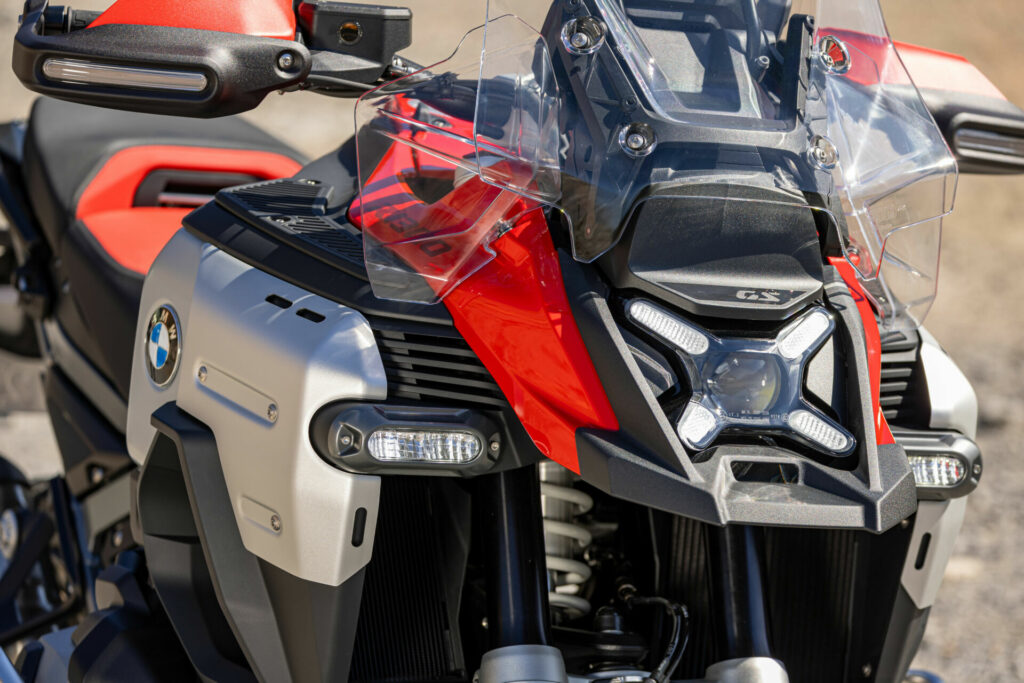
With the optional Adaptive Headlight Pro, the beam of the matrix full LED headlamp turns into the corner according to the lean angle. In this way, the corner is almost fully illuminated because the light moves to where the motorcycle is heading. Due to the adaptive headlight function, the horizon of the light remains relatively constant and is seamlessly adapted to the respective lean angle. This dynamic adjustment of the light cone, also with the support of the daytime running light elements, creates a particularly wide and homogeneous illumination of the road.
Optional Riding Assistant with Active Cruise Control (ACC), Front Collision Warning (FCW) and Lane Change Warning for greater safety and comfort when riding.
The new R 1300 GS Adventure is already equipped with Dynamic Cruise Control (DCC) with braking function as standard. This system can apply the brakes to maintain the selected speed on downhill sections. The optional Riding Assistant offers even more functions. It consists of Active Cruise Control (ACC), Front Collision Warning (FCW), and Lane Change Warning. Active Cruise Control (ACC) enables maximum comfort and the best possible safety when motorcycling: The electronic cruise control with integrated distance control can be used to set the desired riding speed as well as the distance to the vehicle in front. A radar sensor at the front of the motorcycle determines the distance to the vehicle ahead based on the yaw rate and vehicle speed. If this distance decreases, the system reduces speed and automatically restores the desired distance. This frees the mind for carefree riding fun – also ensuring a relaxed ride, especially on lengthy tours.
Front Collision Warning (FCW) with brake intervention is designed to provide protection from collisions and help reduce the severity of accidents while Front Collision Warning uses the ACC radar system to provide protection from rear end collisions.
Lane Change Warning monitors the lanes to the left and right and can help ensure a safe lane change while supporting use of the rear mirror. A radar sensor monitors the area behind the motorcycle, as well as covering the infamous blind spot. If another vehicle is approaching or dangerously close and could potentially be overlooked by the rider, the lane change warning function detects this and warns against changing lanes. This is indicated by a symbol in the respective rear mirror.
Optional new light functions.
Thanks to new light functions, the riding experience on the new R 1300 GS Adventure is even more intense – and there are practical benefits as well: When the ignition is switched on, the so-called “Welcome” light is activated. The main headlamp, rear light and – if available – the auxiliary headlamps light up, remain on for a short time and then fade into standby mode before the engine is started. The transitions are dimmed in stages.
After the ignition has been switched off, the front and rear lights are switched on to “Goodbye” for a brief moment before finally darkening slowly. This function is intended to mark the rider’s departure from the motorcycle – and to make a clear statement at the same time: There’s a BMW here now.
Another new function is for the purpose of guidance (“Follow me home”). After switching off the ignition, the riding light can be activated by briefly pressing the high beam button. The ignition and other non-guidance functions and light sources remain switched off. This light function offers optimum visibility at night, for example when maneuvering in parking spaces or when opening the garage at home.
Standard Comfort rider seats with seat heating for rider and passenger for enhanced touring in Styles Triple Black and Option719.
The new R 1300 GS Adventure offers standard comfort seats and seat heating for rider and passenger in Styles Triple Black and Option 719 variants and as an option on the basic model. This significantly increases comfort on longer journeys and in cold weather.
The Comfort rider’s seats are available in three different seat heights as well as the option to select the seat heating – an optional equipment item that offers three heating levels. The seat height adjustment (+/- 0.8 inches) and the tilt adjustment (4°) are located on the vehicle. The heating functions are operated via a menu function in the TFT display. In combination with the optional seat heating, the heated grips also offer three heating levels. The selection is made via the new multi rocker switch on the left handlebar end: Here it is possible to choose between seat heating and heated grips. The passenger seat heating is operated by a toggle switch with two heating levels that is located at the bottom left-hand side on the seat.
Standard on-board power socket, USB-C socket and ventilated smartphone charging compartment. Optional second available 12-volt auxiliary socket.
The new R 1300 GS Adventure offers two different sockets as standard. A 12-volt on-board power socket is installed on the right-hand side of the cockpit. There is also a USB-C socket with a 5-volt power supply in the hinged smartphone charging compartment on the top of the tank. Charging current is available up to 2.4 A, enabling fast charging depending on smartphone type. This most widely used type of USB-C socket with charging electronics enables a smartphone to be charged while riding by connecting an adapter cable. The original BMW Motorrad accessories include a USB adapter cable for this purpose that has been tested over time and is equipped with a sturdy kink protection. In tried-and-tested BMW Motorrad manner, the external and therefore easily accessible socket is designed to be short-circuit-proof and is protected against overvoltage. Thanks to the integrated sealing cap, it is also effectively protected against environmental influences such as water penetration. An additional 12-volt socket is available as optional accessories. It is located on the right-hand side of the vehicle below the rear frame.
Connectivity: Multifunctional 6.5-inch full-color TFT screen.
The new R 1300 GS Adventure features Connectivity as standard, including a 6.5-inch full-color TFT screen. In conjunction with the standard BMW Motorrad Multi-Controller with integrated operation, it gives the rider fast access to vehicle and connectivity functions. An additional Sport screen enables the display of additional information, making it possible to have the physically experienced riding dynamics of the new R 1300 GS Adventure translated into visible form on the display. Information on lean angle, traction and braking behavior is displayed, as well as a sports rev counter with gear indicator.
This means it is possible to conveniently make a phone call or listen to music during travel. If a smartphone and a helmet with the BMW Motorrad Communication System are connected via Bluetooth to the TFT screen, for example, the rider can conveniently access media playback and telephone functions. These phone and media functions can be used without installing an app. With an active Bluetooth connection to a standard smartphone, the rider can listen to music on the road. In addition, the free BMW Motorrad Connected app offers practical arrow navigation directly via the TFT display. The BMW Motorrad Connected App can be downloaded free of charge from the Google and Apple app stores. It comprises attractive additional functions such as route logging and the display of other travel statistics and information. Recorded routes can also be shared directly with other motorcyclists via the Rever community. The basic navigation is particularly attractive for motorcyclists who want to comfortably manage everyday traffic or short trips without additional equipment.
Standard Intelligent Emergency Call for added safety.
Ensuring the fastest possible assistance in the event of an accident or in situations of emergency and danger can save people’s lives in the cases of an accident involving the rider or the rider coming upon an accident in the road. For this reason, BMW Motorrad has developed an eCall system – “Intelligent Emergency Call” – which aims to get help to the scene of the incident as quickly as possible. The system can be activated automatically or manually by pressing the SOS button on the right handlebar.
Standard Service Assistant for automatic notification when service work is due and for information to be sent from the motorcycle to the BMW Motorrad Connected App.
The Service Assistant service automatically informs the BMW Motorrad dealer (specified in the customer’s BMW ID) that service work is due. This selected authorized dealer then contacts the customer to arrange a service appointment. The Status Report function sends current status data relating to the motorcycle to the BMW Motorrad Connected App – even if the smartphone is not paired with the vehicle. This includes information such as fuel level, remaining range, mileage, and service requirements.
IV. Design and Model Variants
“With the new BMW R 1300 GS we once more took usability and presence to the extreme. We further improved known storage concepts and explored new storage areas we had so far left untouched. This results in an ingenious functionality in all conditions of use – whether on vacation or on expeditions – even in the roughest conditions.”
Alexander Buckan, Head of BMW Motorrad Design
7.9-gallon aluminum fuel tank with clever mounting options and rubberized storage area. Effective wind and weather protection with windshield and hand protectors with hand protector extensions.
The new R 1300 GS Adventure comes with a completely new design that sets it apart from its sister model, the R 1300 GS, even more than before. The design with the new flyline follows the idea of demonstrating the extreme robustness and versatility of the new R 1300 GS Adventure right from the start, without adding unnecessary complexity, but instead intelligently combining materiality and functionality.
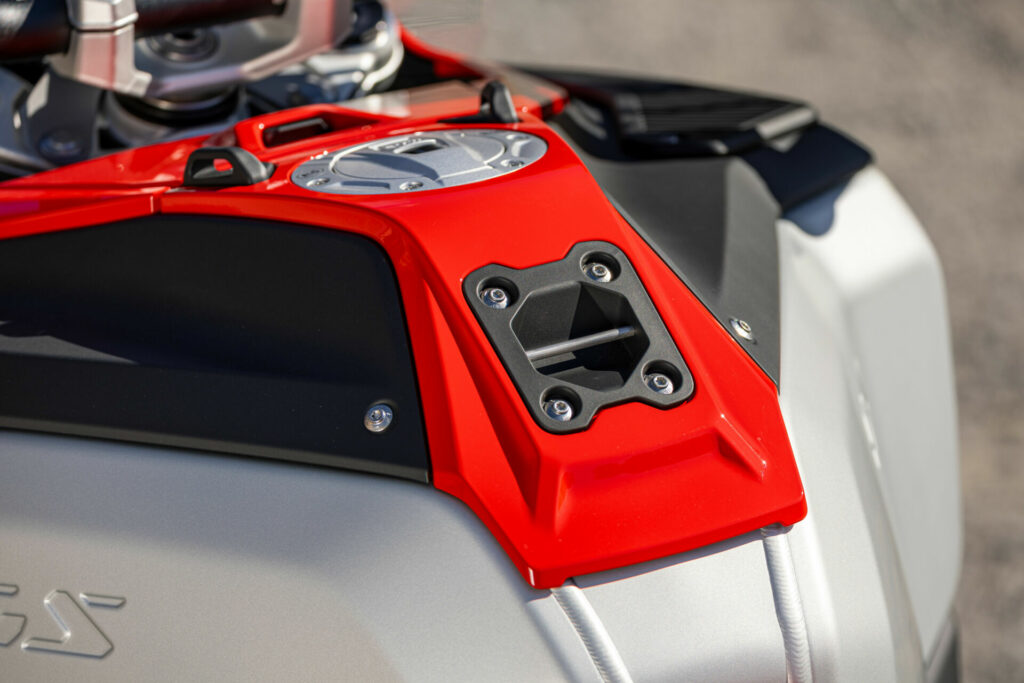
A key component of the outer skin in the central bodywork area of the new R 1300 GS Adventure is the 7.9-gallon aluminum fuel tank, which is largely uncovered. High-quality highlights include recessed BMW emblems and embossed GS lettering on both sides, while two visible welding seams in the seat area demonstrate the technology and manufacturing precision.
It was particularly important to the developers at BMW Motorrad that the tank, with its large outer skin, also fulfils its additional task of carrying a tank bag in a special way. That’s why three fastening elements have been added to the upper tank paneling for easy and simple refueling and quick access to the smartphone charging compartment.
This clever solution offers individual fastening eyelets for items of luggage and at the same time provides an articulated mount with snap lock for the 12-liter tank bag with waterproof inner bag and outer bags, which is available as an accessory. Individual fastening eyelets on the tank also allow luggage to be lashed down.
The sheer width of the tank inspires confidence and provides effective frontal weather protection. Functional, narrow side surfaces integrate the rider perfectly and offer the best possible ergonomic conditions even off-road.
Effective wind and weather protection is provided by the standard large windshield in combination with the two large transparent wind deflectors (cockpit panels), making for a uniquely quiet and comfortable ride, even on long journeys. The optional electric windshield adjustment allows the windshield to be adjusted to the rider’s personal preference with millimeter precision from the comfort of the handlebars. The standard hand protectors with hand protector extensions and integrated turning indicators provide maximum protection for hands and arms. Rubberized tank trays to the left and right of the upper tank covers are also standard. They provide non-slip, secure surface for tools or items during stops.
Maximum variance in rear frame design, from sporty to expedition ready. New aluminum top case and new aluminum cases with integrated magnetic couplings as electrical interfaces for USB charging sockets and lighting, plus optional volume extension.
The modular concept of the new R 1300 GS Adventure allows customers to tailor it entirely to their individual needs and preferences. This concept is brought to life by the innovative design of the aluminum lattice tube rear frame, which serves as the basis for a wide range of independently combinable options to tailor the R 1300 GS Adventure to suit personal tastes and the demands of longer journeys and adventurous touring.
Standard equipment includes a sturdy case holder for mounting a luggage roll or bag, and the comfortable passenger grab handles are functionally and elegantly integrated. The new R 1300 GS Adventure also reveals its sporty character with a slim, short rear tail with sports grab handles and attachment options, as on the R 1300 GS Trophy.
A robust 37-liter aluminum top case and a top case holder with vibration-decoupled top case plate, electrical interface for lighting, central locking, and USB charging socket as well as integrated passenger grab handles are also available as optional accessories.
The maximum load is 17.6 lbs. A passenger backrest pad is optionally available for the aluminum top case. This means that the passenger enjoys even more comfort – both on short trips and long tours. The aluminum top case can also be fitted with a single key locking system as an option.
The new aluminum side cases, each with a load capacity of up to 22 lbs., are also ideal for easy and safe transport of luggage. The total capacity is over 73 liters (37 liters left, 36.5 liters right). They are simply, quickly, and securely attached to the innovative case holders made of forged aluminum. The magnetic coupling integrated into the left-hand case holder acts as the electrical interface for the USB charging socket in the left-hand case. Thanks to the harmonious integration into the rear, the width does not exceed 39.4 inches when both cases are fitted. They can also be fitted with a single key locking system as an option. The optional 10-liter volume extensions per case provide even more storage space. Made from high quality aluminum, they are quick and easy to fit.
Practical inner bags, universal holders and frame and radiator cowl bags for even more flexibility and comfort when transporting luggage.
The new R 1300 GS Adventure offers unrivalled possibilities for storing luggage on the bike, thanks to numerous innovative features from the original BMW Motorrad accessories range. Custom-fit waterproof inner bags are available for both the aluminum side cases and the aluminum top case. The aluminum cases can also be fitted with a storage net in the lid and a carrying handle.
The wide range of universal carriers available for the new R 1300 GS Adventure offers enormous flexibility in terms of luggage storage. They allow items such as rainwear to be easily attached to the aluminum cases using a tightening strap. Designed to match the shape and design of the aluminum cases, they can be easily attached to the front, back and sides of the cases.
The sturdy frame bags are ideal for carrying smaller items that need to stay on the bike. Securely bolted to the rear frame, they have a waterproof inner compartment and a capacity of 2 liters.
The two radiator cowl bags on the left and right provide practical storage space for small items that need to be quickly accessible when travelling. Specially designed to fit the new R 1300 GS Adventure’s radiator grille, they simply snap onto three hooks on the grille for quick attachment and removal. Thanks to the sturdy design of the base and lid, a waterproof inner bag with a capacity of 4 liters and a maximum load of 4.4 lbs. each, they are a robust addition to the innovative storage concept of the new R 1300 GS Adventure.
The BMW R 1300 GS Adventure Basic model variant.
Even in its basic version, the new R 1300 GS Adventure leaves no doubt about its purpose. Finished in solid Racing Red, it has an athletic, trained look that invites you to embark on dedicated motorcycling adventures. The silver-colored tank and the black and red seats for the rider and passenger provide a striking contrast. This color scheme is harmoniously complemented by the black handlebars, black rims, and red hand protector extensions.
BMW R 1300 GS Adventure Style Triple Black.
The Style Triple Black version of the new R 1300 GS Adventure shows its elegant side. Accents in perfectly coordinated shades of black and the aluminum fuel tank finished in high-quality Tinted Clear Coat are the hallmarks of this exceptional character. The appearance of muted, elegant surfaces makes the world-tourer enduro an eye-catcher. The standard engine protector is black with silver inserts. Black handlebars, black wheel rims and grey hand protector extensions are the traditional Triple Black colors. As well as the large aluminum radiator cowls with holders for the radiator cowl bags, this model also features two black/grey comfort seats with seat heating, a luggage holder, and a high windshield with large wind deflectors.
BMW R 1300 GS Adventure Style GS Trophy.
The Style GS Trophy model is focused on off-road capability and features a sporty color scheme. Racing Blue metallic paintwork is complemented by eye-catching solid Light White and solid Racing Red stripes. Textured powder-coated parts in Avus black metallic matt create exciting contrasts with the aluminum parts. The high, red, and black rider’s seat on this model variant creates the effect of a continuous bench seat with the sporty, two-tone passenger seat and matches the red protector extensions. The black insert in the stainless steel engine protector creates an attractive interplay of colors with the black cross-spoke wheels. Black grilles in front of the radiators and auxiliary headlamps provide effective stone guard protection. The smaller sport windshield and sport grab handles for the passenger further emphasize the GS Trophy’s sporty character. Large radiator cowls with mounts for the radiator cowl bags and the aluminum tank trays also form robust docking elements for exploring the world.
BMW R 1300 GS Adventure Option 719 Karakorum.
The Option 719 Karakorum version is finished in an exclusive Aurelius Green metallic matt color, giving it a decidedly elegant look. Gold-colored lines and the Shadow milled parts package complete the high-quality appearance, as does the “Opt. 719” badge on the tank cover. The gold anodized rims and the gold-colored anodized handlebars are particularly eye-catching. The standard engine protector is coated black with silver-colored inserts and the hand protector extensions are grey. In addition to the small aluminum radiator cowls and the protective grille on the auxiliary headlights, this model variant also includes black, heated rider and passenger comfort seats, a luggage rack, and the small Sport windshield.

V. Standard and Optional Equipment
Standard Equipment
- 1,300 cc air/liquid boxer twin motor with ShiftCam technology.
- 6-speed helical toothed gearbox with anti-hopping clutch and shaft drive.
- Steering stabilizer.
- BMW Motorrad EVO Telelever front suspension.
- BMW Motorrad Paralever rear suspension.
- Twin disk front brakes with radial front calipers.
- Cross-spoke wheels.
- Aluminum 7.9-gallon fuel tanks with attachment points.
- BMW Full Integral ABS Pro.
- Dynamic Brake Control.
- DCC Dynamic Cruise Control with brake function (maintains speed on inclines).
- MSR Dynamic Engine Brake Control.
- DTC Dynamic Traction Control.
- Hill Start Assist.
- TPM Tire Pressure Monitor.
- Keyless Ride.
- Riding Modes.
- Heated grips.
- Full LED lighting with Matrix headlight.
- Hand protection with LED Comfort turn signals.
- Adjustable clutch and hand brake levers.
- Electronic immobilizer.
- 6.5-inch TFT display with Connectivity and on-board computer.
- Storage compartment with charging function.
- Multi-function controller.
- 12v power socket.
- Separate rider and passenger seats.
- Luggage Rack.
- Adjustable windscreen.
- Engine protection guard.
- Center Stand.
- M Lightweight battery.
- Intelligent Emergency Call.
- Ultimate Care Break-In Service.
The Ultimate Care Break-In Service, or “600 Mile Service”, is included in the base price of the new 2025 BMW R 1300 GS Adventure to further provide BMW customers with a truly premium experience. Time and mileage limits apply – maximum 6 months from the in-service date or maximum 750 miles – whichever comes first.
Optional Equipment
Premium Package
- Riding Modes Pro.
- Sport Brakes.
- Riding Assistant.
- Shift Assistant Pro or Automated Shift Assistant.
- Headlight Pro.
- GPS prep.
- Chrome plated headers.
- Electrically adjustable windshield.
- Aluminum side case mounts.
- Aluminum top case mount.
Enduro Package Pro
- Handlebar risers.
- Short enduro hand levers.
- Height-adjustable GS Vario rider footrests.
- Hand protectors.
- Front turn signal relocation stalks.
Individual Options
- Passenger Package: Luggage rack, Comfort passenger seat, Style GS Trophy only.
- Enduro forged wheels.
- Double exhaust silencer.
- Adaptive Vehicle Height Control.
- Adaptive Vehicle Height Control Comfort.
- ASA Automated Shift Assistant.
- Comfort handlebars
- High windshield.
- Riding Assistant.
- Anti-theft alarm (dealer installed accessory).
- Off-road tires.
- Cross-spoke wheels (black).
- Cross-spoke wheels II (gold).
- Comfort rider’s seat.
- Comfort rider’s seat, low.
- Comfort rider’s seat, high.
- Comfort passenger seat.
Original BMW Motorrad accessories.
Storage.
- Aluminum side case mounts.
- Aluminum top case with 5V USB charging port, silver.
- Aluminum top case with 5V USB charging port, black.
- Aluminum side cases with 5V USB charging port in left case, silver.
- Aluminum side cases with 5V USB charging port in left case, black.
- Volume expansion set for aluminum side cases, silver.
- Volume expansion set for aluminum side cases, black.
- Universal luggage/accessory adaptor for aluminum cases, side.
- Universal luggage/accessory adaptor for aluminum cases, front/rear.
- Inner bag for aluminum side cases.
- Carry handle for aluminum cases.
- Storage net for aluminum side cases.
- Storage net for aluminum top case.
- Passenger backrest cushion for aluminum top case.
- Inner bag for aluminum top case.
- Passenger seat luggage plate.
- Tank bag, 12 l.
- Frame bag, 2 l.
- Radiator cowl bag, 4 l.
Ergonomics and comfort
- Windshield spoiler
- Black wind deflector, left/right.
- Tinted wind deflector, left/right.
Design.
- Rear axle cover.
Navigation and communication.
- ConnectedRide Navigator.
- ConnectedRide Smartphone Cradle.
Protection.
- Oil fill protection cap, black.
- Headlight guard.
- Rear drive protection guard.
Maintenance and technology.
- Additional power socket.
VI. Technical Data
| R 1300 GS Adventure | |||
| Engine | |||
| Capacity | cc | 1,300 | |
| Bore/stroke | mm | 106.5 x 73 | |
| Output | hp | 145 @ 7,750 rpm | |
| Torque | ft-lbs. | 110 @ 6,500 rpm | |
| Type | Air/liquid-cooled 2-cylinder 4-stroke boxer engine with two overhead, chain-driven camshafts, a counterbalance shaft, and variable intake camshaft control system BMW ShiftCam | ||
| Compression | 13.3/1 | ||
| Fuel | Premium unleaded 95 RON | ||
| Valves per cylinder | 4 | ||
| Ø intake/outlet | mm | 44 / 35.6 | |
| Ø throttle valve | mm | 52 | |
| Engine control | BMS-O | ||
| Emission control | Closed-loop three-way catalytic converter, exhaust standard EU-5 | ||
| Electrical system | |||
| Generator | W | 650 | |
| Battery | V/Ah | 12/14 | |
| Headlight | LED | ||
| Rear light | Function-integrated LED brake/rear lights | ||
| Starter | W | 900 | |
| Power transmission | |||
| Clutch | Wet clutch with anti-hopping function, hydraulically activated | ||
| Gearbox | Claw-shift 6-speed transmission | ||
| Primary ratio | 1.479 | ||
| Transmission ratios | I | 2.438 | |
| II | 1.714 | ||
| III | 1.296 | ||
| IV | 1.059 | ||
| V | 0.906 | ||
| VI | 0.794 | ||
| Secondary drive | Propeller shaft | ||
| Primary ratio | 1.184 | ||
| Secondary ratio | 2.909 | ||
| Chassis | |||
| Frame construction type | Two-part frame concept consisting of main frame and rear frame bolted to it, engine co-supporting | ||
| Front wheel guide | EVO Telelever DSA central strut |
||
| Rear wheel suspension | Cast aluminum single-sided swingarm with BMW Motorrad EVO Paralever, DSA |
||
| Spring travel, front/rear | inches | 8.3 / 8.7 | |
| Wheel castor | inches | 4.7 | |
| Wheelbase | inches | 60.4 | |
| Steering head angle | degrees | 63.8 | |
| Brakes | front | Twin disc brake, semi-floating brake discs, Ø 310 mm, 4-piston radial calipers | |
| rear | Single disc brake, Ø 285 mm, 2-piston floating caliper | ||
| ABS | BMW Motorrad ABS Pro (lean angle optimized) as standard | ||
| Wheels | Cross-spoke wheels | ||
| front | inches | 3.00 x 19” | |
| rear | 4.50 x 17” | ||
| Tires | front | 120/70 R 19 | |
| rear | 170/60 R 17 | ||
| Dimensions and weights | |||
| Total length | inches | 89.8 | |
| Total width incl. hand protect. | inches | 39.8 | |
| Seat height (max range) | inches | 34.3 / 35.0 (31.0 – 36.0) | |
| DIN unladen weight, road ready | lbs. | 593 | |
| Permitted total weight | lbs. | 1,069 | |
| Fuel tank capacity | gallons | 7.9 | |
| Performance figures | |||
| Acceleration 0-100 km/h | seconds | 3.4 | |
| Top speed | mph | >124 | |
BMW Group in America
BMW of North America, LLC has been present in the United States since 1975. Rolls-Royce Motor Cars NA, LLC began distributing vehicles in 2003. The BMW Group in the United States has grown to include marketing, sales, and financial service organizations for the BMW brand of motor vehicles, including motorcycles, the MINI brand, and Rolls-Royce Motor Cars; Designworks, a strategic design consultancy based in California; a technology office in Silicon Valley and various other operations throughout the country. BMW Manufacturing Co., LLC in South Carolina is the BMW Group global center of competence for BMW X models and assembles the X3, X4, X5, X6 and X7 Sports Activity Vehicles as well as the BMW XM. The BMW Group sales organization is represented in the U.S. through networks of 349 BMW passenger car and BMW Sports Activity Vehicle centers,145 BMW motorcycle retailers, 104 MINI passenger car dealers, and 38 Rolls-Royce Motor Car dealers. BMW (US) Holding Corp., the BMW Group’s sales headquarters for North America, is located in Woodcliff Lake, New Jersey.
www.bmwgroup.com and www.bmwmotorcycles.com
Facebook: www.facebook.com/BMWMotorradUSA
Twitter: www.facebook.com/BMWMotorradUSA
YouTube: www.youtube.com/@bmwmotorrad



